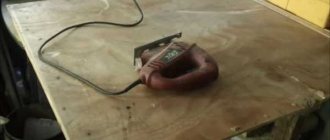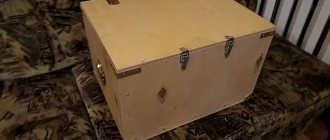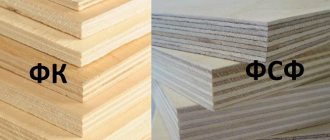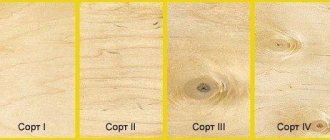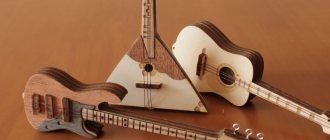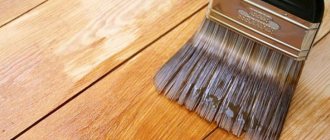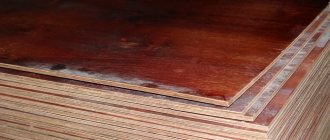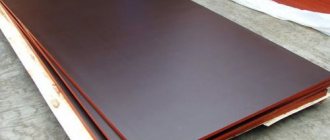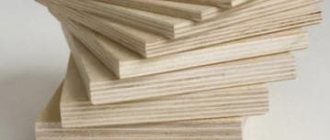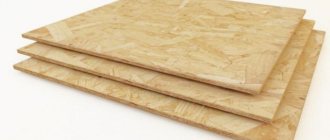The construction and lumber market is constantly changing. Products are modified to improve their technical characteristics. But in the process, manufacturers often push the environmental friendliness of plywood into the background, which can cause serious harm to human health.
This question is especially relevant when choosing building materials for renovating a nursery. Here, safety comes first, since a young and fragile body is very vulnerable, and therefore will not be able to withstand toxins for long.
There are four basic safety principles:
- chemical – a parameter according to which the materials used in residential premises should not emit volatile toxins into the surrounding atmosphere or their concentration should not exceed permissible standards;
- physical – compliance with sound and heat insulation standards;
- firefighter – compliance with flammability standards;
- biological – treatment of materials with safe antiseptic agents that prevent the development of mold or mildew.
Below you can study a short instruction, which contains a description of the main types of plywood, as well as their characteristics. This information will allow you to choose the most rational balance between quality and environmental friendliness.
Application
Plywood has strength, durability, lightness and rigidity. It also has increased resistance to deformation, bending and splitting. In almost every hardware store it can be purchased at a fairly affordable price. Plywood, given its environmental friendliness, is used not only in traditional construction projects, but also in shipbuilding, creating aquariums and tanks.
The use of this material to create furniture and partitions is widespread. Its high strength allows it to be used in combination with ordinary wood or other framing materials. This versatility and environmental friendliness of interior plywood has led to it becoming a favorite among designers and interior decorators.
When purchasing this material, please note that there are different grades. The usual grading system uses numbers from 1 to 4, as well as the letter E - an elite grade that does not allow any defects. Grade 1 - best quality, virtually no defects, very well polished. Grade 4 is extremely low quality, usually containing the maximum permissible number of defects. Double marking. The first number or letter refers to the outside, and the second to the inside. Each variety has its own area of application.
Advantages of plywood:
- Quite resistant to unfavorable climatic conditions.
- Less likely to warp or crack than solid wood.
- It has good appearance and high strength at a lower price.
Cons of plywood:
- The veneer can chip, exposing the less expensive wood underneath.
- The damage is difficult to repair.
- Some types of plywood use glue and formaldehyde.
Nuances of choice: chipboard, plywood or OSB?
Due to the high cost of natural wood and the need to have certain performance properties, wood substitutes in the form of slabs are increasingly being used today.
The most widely used materials in the construction and furniture industry are chipboards (chipboards), plywood and a relatively new material - oriented strand boards (OSB). It is often difficult to understand what the fundamental differences between these materials are and which one to give preference when choosing furniture or construction products. Let's try to put all the information in its place and reveal the key differences between these wood substitutes.
What are the nuances of the production technology of chipboard, plywood and OSB?
The materials under consideration differ precisely in production technology, while their composition is dominated by natural wood components. Chipboard (chipboard) This is a long-known material that has been widely used around the world for several decades. Chipboard is a composite product obtained by hot pressing shavings of different wood species. To impart strength, chipboard manufacturing technology uses an adhesive base and special resinous substances.
Plywood
This multilayer material has a low cost and is therefore widely used in the production of budget furniture and building materials. Plywood consists of several sheets of fairly low quality veneer glued together with a special compound. When matching, veneer sheets are laid so that the fibers are perpendicular to each other. It is noteworthy that one sheet of plywood may contain layers of veneer from various types of wood, which negatively affects the characteristics and properties of the final product.
Oriented Strand Board (OSB)
A new, but already rapidly gaining popularity material, obtained by pressing shavings of mainly coniferous species (under the influence of high temperatures). Natural resinous substances, which are environmentally friendly and safe, are used as a connecting agent in the production of OSB. Under the influence of high temperatures, these resins acquire high bonding properties, making the slab almost monolithic. At the same time, in OSB, 90% of the wood-based particle material accounts for only 10% of the adhesive resin base, which makes it possible to preserve the maximum of the natural properties of wood. All this together makes it possible to widely use OSB in the manufacture of furniture and building materials.
Let's consider the main differences between these materials (based on the main performance characteristics).
Strength In this position, chipboard loses to its competitors, while OSB and plywood have almost identical strength parameters. Resistance to moisture And again, chipboard loses to its “brothers”. Moisture-resistant plywood varieties are successfully used in humid environments. Technological types of OSB can cope with moisture much better than plywood. Wear resistance and reliability All three materials resist physical damage well. Plywood is less susceptible to deformation, unlike chipboard, but it is also prone to drying out and peeling. OSB retains its shape and does not delaminate, despite its multilayer structure.
Environmental friendliness The basis of all three boards is natural wood. However, in the production of oriented strand boards, several times less resinous adhesives are used, and even those are absolutely safe.
Price Chipboard has the most affordable price among the materials under consideration. OSB sheets can be purchased cheaper than moisture-resistant plywood, but the quality of the product will not be worse, and the properties will be much superior to its analogue.
The variety and scope of application of chipboard has rather limited areas of use (due to its unaesthetic appearance and a number of disadvantages). Modern plywood is produced in a different range of colors and shapes, which makes its use more versatile. The same goes for OSB . Oriented strand boards are replacing plywood on the market today, since the material is more technologically advanced and has increased resistance to wear and various external influences. Thanks to a number of advantages and affordability, OSB today comes out on top among materials in the construction and furniture industries. Wall decoration, production of frame furniture, interior decoration, production of panels, facades and much more - oriented strand boards can be successfully used in all of this.
Source: zapodlico.ru
Production
In the plywood manufacturing process, individual layers of veneer are first obtained by rotary cutting of wood. To do this, the logs are rotated around the longitudinal axis, and the cutter cleans it (the thickness of each layer is usually less than 2.5 mm). Next, the glue is applied to the layers using a special machine. It helps in achieving uniform distribution of the glue. In this case, the layers are superimposed on each other and pressed tightly using a hot pressing machine.
The high temperature and pressure created by this technique ensures strong adhesion of the layers. Their number in each sheet of plywood can vary from 3 to 13. The thickness of the sheets from different manufacturers ranges from 3 mm to 30 mm. Standard sheet sizes are 1220 by 2440 mm. There are other sizes that are more convenient to use. It all depends on the manufacturer. The user can cut or sand these sheets according to the required specifications. There are several main types of glue used for manufacturing. The type of plywood, composition, and environmental friendliness should be studied before purchasing.
Plywood or chipboard: advantages and disadvantages of materials
What will be the best choice - chipboard or plywood - depends on what properties of coatings you need.
For example, it is impossible to unequivocally answer the question of what is stronger – plywood or chipboard. Plywood is better able to withstand direct mechanical impacts and is resistant to abrasion. But chipboard begins to deteriorate over time. In addition, nails, screws and self-tapping screws do not adhere very well to chipboards - the material crumbles. But chipboard is considered stronger in bending.
When it comes to moisture resistance, plywood wins here. Even if chipboard is impregnated with a special solution, it will still be more vulnerable in conditions of high humidity.
Both plywood and chipboard do not tolerate moisture well. In rooms with high humidity, mold often forms on them. Materials are susceptible to rotting. Therefore, before installation they should be treated with an antiseptic. And if the humidity is very high, it is better to use OSB for the subfloor.
Chipboard has the best sound and heat insulation properties. If this is an important parameter for your subfloor, it is better to choose particle board.
FSF
Phenol-formaldehyde adhesive is a type of synthetic or man-made polymer that is produced by chemical reactions of phenol and formaldehyde.
Phenolic resins provide a stronger bond than urea-based substances. Hence, they are used in making stronger and better quality plywood. The moisture resistance of this material is very high. The marking is as follows: FSF. The main and very significant disadvantage of formaldehyde resins is the harmful substances included in their composition. Their use is unacceptable for furniture production and residential premises.
What is the difference between plywood and chipboard?
Both materials contain wood. But plywood is called more environmentally friendly. And that's why:
Plywood is layers of veneer firmly glued together. Essentially, the material consists of the thinnest sheets of inexpensive wood and synthetic layers.
- And chipboard is a chipboard made from compressed small shavings. In this case, much more glue is used.
Both of these materials are used as a rough substrate for laminate, parquet, linoleum and other floor coverings. Using chipboard or plywood, the surface is leveled and insulated. The result is a higher quality, stronger and more durable coating.
FC and FBA
There are no harmful substances in the composition of urea and albumin casein glue. As a result, the plywood in which they are used can be used in the finishing of any buildings, even kindergartens. It is also used in furniture. The main drawback is that this material is not waterproof. In FC plywood, environmental friendliness is ensured by the safe urea adhesive used in its production. FBA plywood contains albinocasein glue.
Safety of building materials
All materials used for interior finishing work must meet basic safety criteria:
- Chemical – the concentration of harmful vapors released is not more than the maximum permissible norm.
- Physical - they do not have increased thermal conductivity.
- Fire - have low flammability and meet fire safety criteria.
- Biological - products and structures made from building materials located indoors must be pre-treated with antiseptics to prevent the development of mold. Antiseptic compositions do not contain harmful substances that can be released into the atmosphere.
Only if all these requirements are met can we talk about the complete safety of the material.
FB
Sometimes moisture resistance is a priority requirement. In these cases, marine plywood is used. In the production of this material, the best brands of moisture-resistant bakelite glue are used. Such plywood is most often marked as follows: FB. It has two top quality surfaces but a limited selection of hardwoods that are suitable for marine use. As a rule, birch is used. Marine plywood is much more difficult to find. It costs more than other varieties of this material. Depending on the gluing method, there are subtypes of plywood:
- FBS – impregnated with alcohol-soluble glue and has increased moisture resistance.
- FBV – is impregnated with water-soluble glue and has increased strength.
Formaldehyde in plywood
Formaldehyde is the simplest substance from the group of aldehydes. Upon direct contact, it irritates the skin and mucous membranes, and if ingested, it affects the nervous system. Its maximum permissible concentration (MPC) in the air is 0.5 mg/m3. If the concentration of formaldehyde exceeds these values, a person’s well-being may worsen. The lethal dose is 60-90 ml, taken orally once. This corresponds to about 50-70 g of substance based on weight.
So is plywood harmful to humans if it contains urea or phenol-formaldehyde resins? To answer this question, you need to know how much formaldehyde is included in its composition. Depending on the content of this substance, plywood sheets are divided into the following emission classes:
- E0 – formaldehyde is completely absent, and therefore it is not released into the air in any quantities. This kind of plywood is not produced in Russia, but this emission class exists in the USA.
- E1 – 100 g of plywood products contain up to 10 mg of formaldehyde. This includes FC, FBA and FBV plywood, which you can buy from us at a low price with delivery throughout Moscow and Moscow Region. When these sheets are kept indoors, no more than 0.124 mg of formaldehyde is released into each m 3 of air.
- E2 - 100 g of material contains from 10 to 30 mg of formaldehyde, and more than 0.124 mg of this substance is released into the air for each m3. This includes sheets FSF, FBS and FOF. Our warehouse always stocks these brands of plywood with an attractive price, as well as a large assortment of formats and thicknesses.
- E3 – 100 g of material contains 30-60 mg of formaldehyde. The production of such plywood is prohibited due to its high toxicity.
The safest plywood in Russia is produced by Syktyvkar Plywood Plant LLC. It produces products with emission class E0.5, which fully complies with European standards. 100 g of such material contains up to 2.4 mg of formaldehyde.
Environmental friendliness of plywood and harm to health
Materials containing formaldehyde resins, according to European standards, are divided into 3 categories (E0, E1, E3). The number shows the level of harmful substances. The safest plywood is E0.
The use of veneer expands the possibilities of using natural wood species. Veneer is an absolutely natural material. However, the production of plywood requires significantly less wood compared to solid wood products. This reduces the number of trees cut down. Veneer is an environmentally friendly alternative to hardwood.
There are health concerns about the adhesives used in wood production because they contain harmful substances. This especially applies to phenol and formaldehyde. Not so long ago they were considered safe for health, but now the opinion of experts has changed dramatically. Research shows that these substances negatively affect people's health.
Allergic reactions, headaches, breathing problems and all kinds of inflammation are some of the possible problems caused by these substances. Carcinogenic properties are also attributed to phenol-formaldehyde compounds. The proportion of harmful substances in modern plywood is small, but they are present. This fact should not be ignored.
What is known about phenol
Phenol is a derivative of benzene. This is a toxic substance for humans, which, when ingested, affects the visual center and central nervous system. The lethal dose for humans is 5-10 g, and the MPC is 1 mg/m3 of air. Does this mean that phenol-containing plywood is dangerous?
Only waterproof types of plywood contain phenol - FSF, FOF, FBV and FBS. But it makes up only 11% of the total mass of resin used to glue the veneer. Everything else is formaldehyde. In this regard, phenol does not have a significant effect on human health. But as a precaution, materials containing this substance are not recommended for interior decoration.
Reducing exposure
Modern science does not stand still. Methods are being developed to help increase the environmental friendliness of plywood. One solution is to create a modified adhesive based on phenol-formaldehyde resin. It contains wheat flour and chalk, which increase the elasticity and viscosity of the adhesive joint. Moreover, they are natural products. This improves toxicity indicators and promotes energy saving in production.
There is also currently a concerted effort by manufacturers in different countries to develop completely environmentally friendly adhesives to make plywood a completely safe material for people and the environment. An alternative may be adhesives such as soy-based amino acids. They do not contain pollutants that cause gases. Safety plywood is also produced with an agrofibre or wheat straw core, which further makes it environmentally compliant.
Russia is a country with a fairly developed woodworking industry. Our plywood production has long traditions and a high level of accumulated knowledge. Rich forest resources and competitive production provide good opportunities to invest in new technologies, resulting in more sustainable plywood.
Which plywood is environmentally friendly?
In fact, a phrase such as “environmentally friendly plywood” is nothing more than an advertising ploy, since in the manufacture of plywood various adhesive bases are used, which in principle cannot be environmentally friendly, since for the purity of the material it is necessary to use biologically and chemically neutral ingredients, but they are very expensive and the cost of such plywood then turns out to be unaffordable even for wealthy people.
But there is one BUT. There are some standards for the content of hazardous and harmful substances in plywood, and the lower these percentages and grams, the more environmentally friendly the plywood is considered, although I would say differently - less hazardous to health.
So, it is believed that FBA is the most environmentally friendly plywood today, since albumin-casein glue is used in its production; it is natural, made on a protein basis, which makes the plywood clean, but this plywood still contains harmful substances.
Modern manufacturers, including plywood, are trying to improve the environmental friendliness of their products in the fight for buyers. However, look at the following nuances.
It is believed that special chemical additives that are part of the adhesive of FSF plywood boards (formaldehyde resin plywood) combine formaldehyde and prevent its evaporation. Therefore, according to standards adopted in many European countries, the use of FSF plywood with emission class E1 is authorized even in the manufacture of furniture for children.
However, in accordance with the same standards, for interior finishing work, it is allowed to use only FK plywood (plywood), with the same emission class E1 (although the urea contained in the glue, for example in Russia, is classified as moderately hazardous substances of class 3
Therefore, while environmentally friendly plywood does not exist, the question of which brand of plywood is considered more environmentally friendly - FSF or FK, in my opinion, remains open.
Indeed, phenol-formaldehyde is contained in most types of plywood, and also contains other substances that are not very beneficial to our health, so only natural wood without chemical treatment can make our life truly environmentally friendly.
But as for the question of which plywood is more environmentally friendly, the answer is quite simple. Each plywood has a classification code. So, for example, according to maximum permissible concentrations, that is, according to maximum permissible concentrations, types of plywood are divided into several classes with numerical and letter designations.
This is what these symbols look like:
E0 - 6 or less mg/100 g; E1 - from 9 to 7 mg/100 g; E2 - from 10 to 20 mg/100 g.
From this example it is clear that plywood marked E0 has the least harmful impurities in its composition. And categories E1 and E2 contain much more formaldehyde in the ratio of milligrams per hundred grams of plywood.
When I read the question, it occurred to me that fiberboard plywood is perhaps the least impregnated with any binders. In principle, it turned out that way. Of all types of plywood, fiberboard under normal operating conditions, with the lowest resin content, is the most environmentally friendly. But there was one problem here too. When plywood is heated, emissions of harmful compounds into the atmosphere sharply increase, and the maximum permissible concentration immediately goes off scale. So if we talk about plywood, this material has never been and is not useful from an environmental and health point of view. But veneer itself is a natural and harmless product.
The main volume of plywood in Russia is represented by multilayer plywood made from peeled veneer, obtained by hot pressing a package of birch veneer, pre-treated with adhesives based on urea-formaldehyde and phenol-formaldehyde resins.
All plywood with a urea-formaldehyde binder releases formaldehyde and methanol into the indoor air. Formaldehyde is a carcinogen and as such is listed as a carcinogen by the World Health Organization. Methanol is also a highly toxic substance.
It is quite widely known that according to European standards, CSAs with formaldehyde binders are divided into three categories based on the formaldehyde content in mg/100 g of material: E0 - 6 or less mg/100 g; E1 - from 9 to 7 mg/100 g; E2 - from 10 to 20 mg/100 g.
The best types of plywood produced in the Russian Federation correspond only to class E2. In the countries of Eastern and Western Europe, plywood of class E1 is produced, obtained through the use of KF resins with a sharply reduced content of formaldehyde and methanol. However, neither E1 nor even E2 plywood is suitable for widespread use in construction. There are two reasons for this: 1) cured CF resins, regardless of any circumstances, constantly split off formaldehyde, and 2) the level of its release into indoor air increases with increasing temperature and humidity.
In Russia, the MPC value for formaldehyde has been officially established as 0.003 mg/m3 of air - this is the strictest MPC in the world, which is caused by the proven carcinogenicity of formaldehyde. Because of this, any plywood used for subfloors or finishing walls and ceilings will create a concentration of formaldehyde in the room that is 10 or more times higher than the maximum permissible concentration.
In order to return plywood as a finishing material to housing construction, a number of serious measures are needed to improve the quality of the resin and introduce components into the adhesives that actively absorb (irreversibly) formaldehyde throughout the entire life of the plywood, that is, to implement a set of technological and compositional innovations, boiling down to a radical detoxification of plywood. As for bakelite plywood of the above brands, they are even more toxic than plywood based on urea-formaldehyde binders, since, in addition to formaldehyde and methanol, they emit highly toxic phenol into the air. The presence of formaldehyde, methanol and phenol in the air at the same time turns the room into a real gas chamber.
Environmental Features
To understand which material is safer, you need to compare the main environmental characteristics. There are 4 main indicators of environmental friendliness:
- fire safety . There are several fire safety groups. We need group "G", which has 5 categories. The higher the number, the less safe the material. Plywood products for construction work belong to category G1;
- physical safety . This includes an indicator of thermal conductivity and thermal resistance. Normal values of these indicators indicate that the material absorbs sounds well and does not accumulate charges;
- biological safety . This indicator is calculated according to the number of applicable antifungal impregnations, which contain harmful components. And now there are a lot of impregnations;
- chemical safety . This characteristic takes into account the permissible concentration of chemicals (poisonous, toxic).
Taking into account all these 4 indicators, you can choose the right material and not worry about your health and your family, but is everything so simple?
What is more harmful: FC or FSF
Many people are interested in which plywood is less harmful: FC or FSF. To answer this question, let's look at the information discussed above. Based on this, we draw three conclusions:
- The harm of FC plywood is less, since it contains only one of the dangerous components - formaldehyde.
- There are more harmful emissions from FSF plywood, since it contains both formaldehyde and phenol.
- The harm from FSF plywood is higher, since it belongs to the second emission class - E2.
That is why it is recommended to use only FC plywood in interior spaces. FSF and FOF sheets are intended for external use. This is due to the fact that in open space toxic compounds immediately evaporate and cannot cause harm to humans. Using plywood according to the recommendations, you will not harm yourself or your loved ones.
Which plywood to choose: a guide to material selection
- operational purpose (construction, general use, furniture, decorative, etc.);
- degree of water resistance of the adhesive joint;
- type of surface treatment (polished/unpolished);
- thickness and number of layers;
- sheet dimensions;
- emission class, etc.
Which plywood is better for the floor: which one to use, lay it, what grade to choose, how to lay it in photos and videos
Plywood is quite durable, and at the same time, a natural material. Unique mechanical properties are imparted to plywood due to a special manufacturing technology, which involves gluing an odd number of thin layers of wood veneer with perpendicular alternation of fibers.
Expert opinion
Strebizh Viktor Fedorovich, leading construction foreman
Before moving on to the next topic, it is necessary to mention that there is another standard that classifies materials containing formaldehyde into such categories. If you want to clarify something, please contact me!
Negative effects of plywood on the human body
- If you plan to install adjustable floors, then logs will not be required; you only need special fasteners installed under the plywood.
- It is possible to lay plywood sheets on joists or floor beams. In this case, you need to understand which plywood is best to use for floor joists. You will need slabs of at least 12 mm and a finished frame base. This kind of floor will require the most time to implement; it is necessary when you need to insulate the floor or raise it to the required height. The use of adjustable joists eliminates differences in floor heights. This is why adjustable joists are often used by builders.
